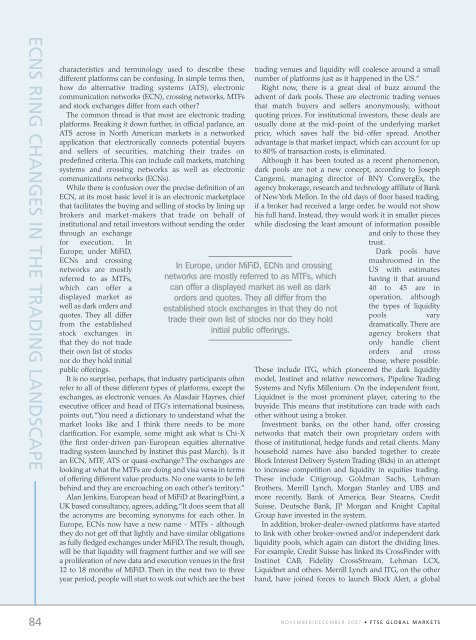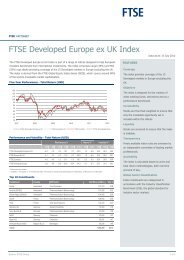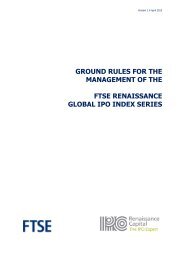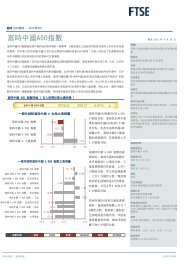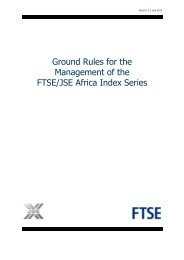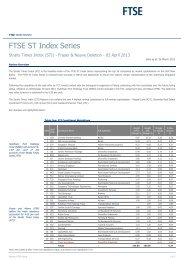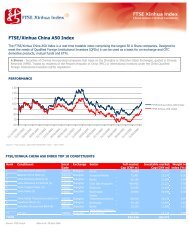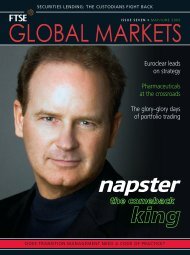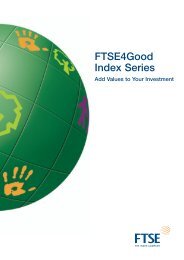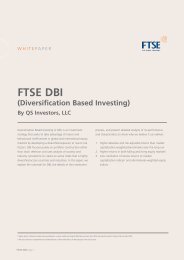Section 2 - FTSE
Section 2 - FTSE
Section 2 - FTSE
Create successful ePaper yourself
Turn your PDF publications into a flip-book with our unique Google optimized e-Paper software.
ECNS RING CHANGES IN THE TRADING LANDSCAPE<br />
84<br />
characteristics and terminology used to describe these<br />
different platforms can be confusing. In simple terms then,<br />
how do alternative trading systems (ATS), electronic<br />
communication networks (ECN), crossing networks, MTFs<br />
and stock exchanges differ from each other?<br />
The common thread is that most are electronic trading<br />
platforms. Breaking it down further, in official parlance, an<br />
ATS across in North American markets is a networked<br />
application that electronically connects potential buyers<br />
and sellers of securities, matching their trades on<br />
predefined criteria. This can include call markets, matching<br />
systems and crossing networks as well as electronic<br />
communications networks (ECNs).<br />
While there is confusion over the precise definition of an<br />
ECN, at its most basic level it is an electronic marketplace<br />
that facilitates the buying and selling of stocks by lining up<br />
brokers and market-makers that trade on behalf of<br />
institutional and retail investors without sending the order<br />
through an exchange<br />
for execution. In<br />
Europe, under MiFiD,<br />
ECNs and crossing<br />
networks are mostly<br />
referred to as MTFs,<br />
which can offer a<br />
displayed market as<br />
well as dark orders and<br />
quotes. They all differ<br />
from the established<br />
stock exchanges in<br />
that they do not trade<br />
their own list of stocks<br />
nor do they hold initial<br />
public offerings.<br />
It is no surprise, perhaps, that industry participants often<br />
refer to all of these different types of platforms, except the<br />
exchanges, as electronic venues. As Alasdair Haynes, chief<br />
executive officer and head of ITG’s international business,<br />
points out,“You need a dictionary to understand what the<br />
market looks like and I think there needs to be more<br />
clarification. For example, some might ask what is Chi-X<br />
(the first order-driven pan-European equities alternative<br />
trading system launched by Instinet this past March). Is it<br />
an ECN, MTF, ATS or quasi-exchange? The exchanges are<br />
looking at what the MTFs are doing and visa versa in terms<br />
of offering different value products. No one wants to be left<br />
behind and they are encroaching on each other’s territory.”<br />
Alan Jenkins, European head of MiFiD at BearingPoint, a<br />
UK based consultancy, agrees, adding,“It does seem that all<br />
the acronyms are becoming synonyms for each other. In<br />
Europe, ECNs now have a new name - MTFs - although<br />
they do not get off that lightly and have similar obligations<br />
as fully fledged exchanges under MiFiD.The result, though,<br />
will be that liquidity will fragment further and we will see<br />
a proliferation of new data and execution venues in the first<br />
12 to 18 months of MiFiD. Then in the next two to three<br />
year period, people will start to work out which are the best<br />
In Europe, under MiFiD, ECNs and crossing<br />
networks are mostly referred to as MTFs, which<br />
can offer a displayed market as well as dark<br />
orders and quotes. They all differ from the<br />
established stock exchanges in that they do not<br />
trade their own list of stocks nor do they hold<br />
initial public offerings.<br />
trading venues and liquidity will coalesce around a small<br />
number of platforms just as it happened in the US.”<br />
Right now, there is a great deal of buzz around the<br />
advent of dark pools. These are electronic trading venues<br />
that match buyers and sellers anonymously, without<br />
quoting prices. For institutional investors, these deals are<br />
usually done at the mid-point of the underlying market<br />
price, which saves half the bid-offer spread. Another<br />
advantage is that market impact, which can account for up<br />
to 80% of transaction costs, is eliminated.<br />
Although it has been touted as a recent phenomenon,<br />
dark pools are not a new concept, according to Joseph<br />
Cangemi, managing director of BNY ConvergEx, the<br />
agency brokerage, research and technology affiliate of Bank<br />
of New York Mellon. In the old days of floor based trading,<br />
if a broker had received a large order, he would not show<br />
his full hand. Instead, they would work it in smaller pieces<br />
while disclosing the least amount of information possible<br />
and only to those they<br />
trust.<br />
Dark pools have<br />
mushroomed in the<br />
US with estimates<br />
having it that around<br />
40 to 45 are in<br />
operation, although<br />
the types of liquidity<br />
pools vary<br />
dramatically. There are<br />
agency brokers that<br />
only handle client<br />
orders and cross<br />
those, where possible.<br />
These include ITG, which pioneered the dark liquidity<br />
model, Instinet and relative newcomers, Pipeline Trading<br />
Systems and Nyfix Millenium. On the independent front,<br />
Liquidnet is the most prominent player, catering to the<br />
buyside. This means that institutions can trade with each<br />
other without using a broker.<br />
Investment banks, on the other hand, offer crossing<br />
networks that match their own proprietary orders with<br />
those of institutional, hedge funds and retail clients. Many<br />
household names have also banded together to create<br />
Block Interest Delivery System Trading (Bids) in an attempt<br />
to increase competition and liquidity in equities trading.<br />
These include Citigroup, Goldman Sachs, Lehman<br />
Brothers, Merrill Lynch, Morgan Stanley and UBS and<br />
more recently, Bank of America, Bear Stearns, Credit<br />
Suisse, Deutsche Bank, JP Morgan and Knight Capital<br />
Group have invested in the system.<br />
In addition, broker-dealer-owned platforms have started<br />
to link with other broker-owned and/or independent dark<br />
liquidity pools, which again can distort the dividing lines.<br />
For example, Credit Suisse has linked its CrossFinder with<br />
Instinet CAB, Fidelity CrossStream, Lehman LCX,<br />
Liquidnet and others. Merrill Lynch and ITG, on the other<br />
hand, have joined forces to launch Block Alert, a global<br />
NOVEMBER/DECEMBER 2007 • <strong>FTSE</strong> GLOBAL MARKETS


